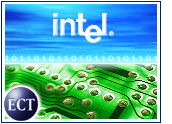
Intel has previewed its next wave of computer chip advancements, promising to bring server virtualization technology to the desktop and professing its readiness for the convergence of wireless and multimedia technologies.
The centerpiece of Intel’s annual developers forum was a preview of Vanderpool technology, which will enable a single chip to act as two virtual central processing units. Intel, saying the technology is less than five years away from becoming prevalent on desktops, urged software developers to use that window to build programs that can leverage this newfound computing power.
“The focus of the effort is on enhancing the end-user experience by partitioning inside the chip,” Intel president and COO Paul Otellini said, demonstrating the technology by using a single PC to view a television show and play a video game.
Home Front
In fact, much of Intel’s preview focused on home computer use, with the company seeming to suggest the sky is the limit for wireless networking offerings that build on the popularity of its Centrino mobile chip for notebooks, released earlier this year.
Otellini predicted the wireless convergence trend could give the entire computer, electronics and entertainment industries a much-needed boost.
“The proliferation of wireless is nothing short of viral,” he said. “Consumers are going to be seeking products and services to make the most of this technology.”
Standard Shift
Still, hurdles clearly remain, most notably a need to establish standards so that computers and electronics can actually work together well. Such standards could take another year to establish.
“Everyone has their sights set on the home in terms of where the next big market is going to lie,” IDC senior analyst for semiconductors Shane Rau told the E-Commerce Times. He noted that hardware makers, such as Dell and Gateway, already have begun to feature consumer electronics in their product lines.
Because of its role in creating the building blocks of that technology, Intel plays a key part in setting the stage for what comes next. “Intel’s role is to start the ball rolling by getting developers excited about the opportunities as well,” Rau said.
Names and Dates
In addition to Vanderpool, Intel also highlighted its push to build chips that are inherently more secure, an effort it has dubbed LaGrande. The technology, which Intel said is about two years from being ready for market, is aimed at foiling some favorite hacker tricks, such as tracking keystrokes to unlock security codes.
The chip giant also shone the spotlight on its Tanglewood family of high-performance computing chips, saying they will achieve speeds seven times as fast as currently marketed chips. The company did not offer a time frame for the processors, except to say that Tanglewood will be preceded by Montecito, which will become available in 2005.













































Social Media
See all Social Media